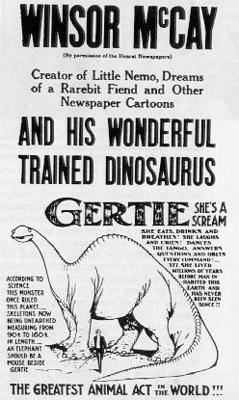Sorry for the tease. Yesterday's entry marked my acquisition of an original drawing from a 1914 cartoon called "Gertie the Dinosaur," created by the man I consider the best cartoonist who ever lived, Winsor McCay. Some references call Gertie the first cartoon, but she wasn't. There had been several earlier experiments. What Gertie was was the first animated star and, in my opinion, way ahead of her time. Years before Disney's rubber-legged "Steamboat Willie," Gertie the Dinosaur had substance and personality.
(Gertie was actually McCay's third try at animation. His first two short films, featuring a boy (Little Nemo) and a mosquito, were supposedly so convincing to audiences of the time that they thought he'd somehow shot them in real life. So for his third movie, McCay decided to feature a creature he couldn't possibly have filmed live: a dinosaur.)

McCay used his Gertie movie as part of a live vaudeville act in which he interacted with the dinosaur on the screen. She did tricks on command. At one point in the performance, McCay threw food behind the screen that Gertie caught and ate on-screen. At the conclusion, McCay himself "stepped" into the screen and an animated version of the cartoonist took a ride on the beast. By all accounts, the performance was a sensation.
Until the advent of computers, virtually all animation was done on cels, transparent celluloid sheets onto which the characters were inked and painted. Artists only made multiple individual drawings for objects that moved--sometimes an entire figure, sometimes just an arm or mouth. Because cels are transparent, the animators only needed to create one background painting for each scene, on top of which they layered the cels and shot one frame of film. Then they swapped out the bits that moved and shot another frame. Repeat 100,000 times and you've got a movie.
In 1914, they hadn't figured that out yet. In Gertie, Winsor McCay and a single assistant hand-drew both character and background in every frame. Every single frame. They redrew every rock, water ripple, and blade of grass thousands of time on sheets of rice paper that, like tracing paper, were transparent enough to allow them to copy from a master drawing underneath. Then McCay glued each sheet to a piece of cardboard so they all lined up, and shot them.
There are somewhere between 200 and 300 original Gertie cels left. As I said yesterday, until a few years ago I assumed they were long destroyed. Once I discovered otherwise, I learned all I could about them and kept my eyes open. Finally, a couple of weeks ago, everything came together: a beautiful full-figure Gertie pose, good condition, a reputable dealer, and a fair price. I couldn't pass it up. I'd always resolved that I didn't deserve to have a Gertie until I could pay for it with my earnings from cartooning. Thanks to Abrams, that finally came together, too.
To read more about Winsor McCay and Gertie, see
http://www.bpib.com/illustrat/mccay.htm.

0 comments:
Post a Comment